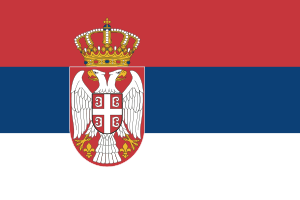Serbian facts for kids
Serbian refers to things connected to the country Serbia. It can mean the people who live in Serbia, their culture, or their language. When you hear "Serbian," it often points to the Serbian language or the special alphabet they use, called the Serbian Cyrillic alphabet.
Contents
What is Serbia?
Serbia is a country located in Southeast Europe, in a region known as the Balkans. It's a landlocked country, meaning it doesn't have a coastline. The capital and largest city is Belgrade, which is one of the oldest cities in Europe. Serbia has a rich history, with many different empires and cultures influencing it over thousands of years.
Where is Serbia?
Serbia is located at a crossroads between Central and Southern Europe. It shares borders with several countries: Hungary to the north, Romania and Bulgaria to the east, North Macedonia and Kosovo to the south, and Montenegro, Bosnia and Herzegovina, and Croatia to the west. Its location has made it an important place for trade and cultural exchange throughout history.
Serbian Culture and History
Serbian culture is a mix of influences from the East and West. It has strong traditions in folk music, dance, and literature. Many Serbians are Orthodox Christians, and their faith plays a big part in their holidays and customs. Serbia has a long and sometimes complex history, including being part of the Ottoman Empire and later Yugoslavia. Today, Serbia is an independent republic working to build its future.
The Serbian Language
The Serbian language is a South Slavic language. It is spoken mainly in Serbia, but also in Bosnia and Herzegovina, Montenegro, and by Serbian communities around the world. What makes Serbian interesting is that it uses two different alphabets: the Serbian Cyrillic alphabet and the Latin alphabet. Both are used in daily life, and people can usually read and write in both.
Serbian Cyrillic Alphabet
The Serbian Cyrillic alphabet is a special version of the Cyrillic alphabet. It was created in the 19th century by a language reformer named Vuk Karadžić. He made it very simple: each letter represents only one sound, and each sound is written with only one letter. This makes it very easy to learn how to read and write once you know the letters. For example, the letter "А" always makes the "ah" sound, just like in "father."
See also
 In Spanish: Serbio para niños
In Spanish: Serbio para niños


